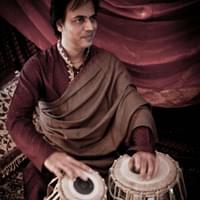
Sitar & Tabla
15 October 2024, 8:45pm - 9:45pm
Sitar player Jasdeep Singh Degun recently became the first Indian Classical musician to win the prestigious Royal Philharmonic Society Instrumental Award. The RPS judges said that ‘Rainbows of sound burst from his instrument in the dazzling collaborations of his debut album ... He excels on so many remarkable levels.’ Jasdeep’s lifelong training has been in gayaki ang, a lyrical approach to the sitar that mimics the human voice. Tonight he is joined by world-renowned tabla player Sanju Sahai for a programme of intimate duets and masterful improvisations rooted in many years of Indian tradition.
Notes on the Programme
The performance of a raga or raag in Indian classical music is akin to the telling of a story in many ways. It is a narrative interpreting a traditional melody which has often been handed down through generations, giving each performer the scope to include their own version of events and to convey the full extent of their imagination and creative vision. For a raag to be fully articulated the soloist takes the listener through a series of ‘movements’. This is an established structure which gives the artist an opportunity to demonstrate the full range of their musicianship and shows us that raag is something beyond merely a melodic framework, but which according to ancient Sanskrit texts 'colours’, or even opens, the mind. The point at which an artist chooses which raag to play for any concert can vary according to their sense of the specific occasion, the time of day or even the time of year.
This rendition of Indian classical music features the sitar, a stringed instrument which is perfectly equipped to portray the full range of emotions and dynamics which encapsulates the essence of raag music. The meditative introductory section known as alap, establishes the mood and provides an opportunity for the soloist to creatively interpret the chosen raag’s unique melodic phrases. Alap is characterised by a discernible absence of pulse featuring subtle ornamentations and detailed improvisations. The beginning of the recital emanates a sense of tranquillity and peacefulness since the phrases are reflective and not hurried. In this way the soloist explores the raag’s beauty and subtleties in depth. For this phase of the recital the focus is solely on the sitar. This section of alap can take up to half of the recital, though this isn't pre-arranged and can vary depending on several factors including the nature of the raag and the creative mood of the artist. While raags are traditionally associated with moods such as joy, serenity and pathos, and linked with particular seasons and times of the day, there is significant scope here for the artist to express their own emotions and aesthetics through the music. This is the beauty of Indian classical music.
There can be three distinctive sections for the alap section, known as alap, jor and jhalla. Jor sees the introduction of a soft, gentle pulse which provides the backdrop for further elaboration, while the jhalla injects energetic rhythm into the recital and features more virtuosic playing. Up to this point, the tabla player has been able to soak up the mood of the music but is now given a chance to actively contribute as the soloist introduces the first composition (known as gat), that is a melody with a clear rhythmic structure. From hereon the performance takes on a more interactive nature, offering the opportunity for the two performers to trade phrases and respond to each other's creative imagination. The composition begins at a slow pace and works its way to a thrilling climax, through two, or even three different compositions, though the emphasis is always on spontaneous improvisation.
Credit: John Ball

